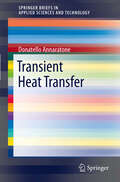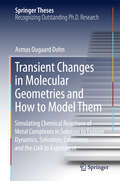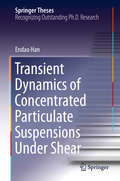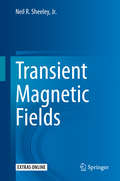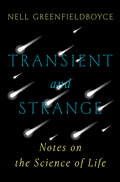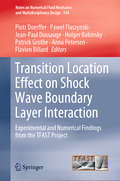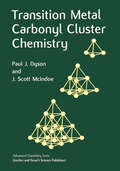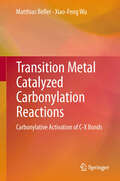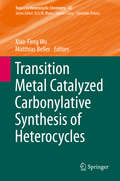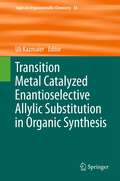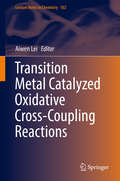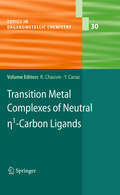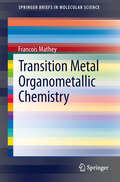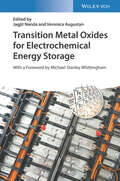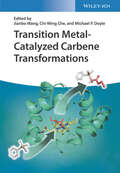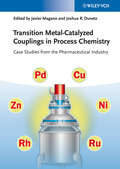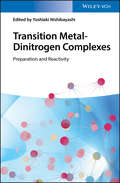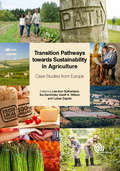- Table View
- List View
Transient Heat Transfer
by Donatello AnnaratoneThis book presents a new and direct computational method for transient heat transfer. The approach uses the well-known dimensionless Biot number and a second dimensionless number introduced by the author. The methodology allows for a transient heat transfer calculations without using finite difference programs. The book presents many examples and various tables demonstrating the potential of this new methodology. Many diagrams illustrate the physical phenomena.
Transient Changes in Molecular Geometries and How to Model Them
by Asmus Ougaard DohnThis thesis examines various aspects of excess excitation energy dissipation via dynamic changes in molecular structure, vibrational modes and solvation. The computational work is carefully described and the results are compared to experimental data obtained using femtosecond spectroscopy and x-ray scattering. The level of agreement between theory and experiment is impressive and provides both a convincing validation of the method and significant new insights into the chemical dynamics and molecular determinants of the experimental data. Hence, the method presented in the thesis has the potential to become a very important contribution to the rapidly growing field of femtosecond x-ray science, a trend reflected in the several free-electron x-ray lasers (XFELs) currently being built around the world. Light-induced chemical processes are accompanied by molecular motion of electrons and nuclei on the femtosecond time scale. Uncovering these dynamics is central to our understanding of the chemical reaction on a fundamental level. Asmus O. Dohn has implemented a highly efficient QM/MM Direct Dynamics method for predicting the solvation dynamics of transition metal complexes in solution.
Transient Chaos
by Ying-Cheng Lai Tamás TélThe aim of this Book is to give an overview, based on the results of nearly three decades of intensive research, of transient chaos. One belief that motivates us to write this book is that, transient chaos may not have been appreciated even within the nonlinear-science community, let alone other scientific disciplines.
Transient Dynamics of Concentrated Particulate Suspensions Under Shear (Springer Theses)
by Endao HanThis thesis demonstrates the first use of high-speed ultrasound imaging to non-invasively probe how the interior of a dense suspension responds to impact. Suspensions of small solid particles in a simple liquid can generate a rich set of dynamic phenomena that are of fundamental scientific interest because they do not conform to the typical behavior expected of either solids or liquids. Most remarkable is the highly counter-intuitive ability of concentrated suspensions to strongly thicken and even solidify when sheared or impacted. The understanding of the mechanism driving this solidification is, however, still limited, especially for the important transient stage while the response develops as a function of time. In this thesis, high-speed ultrasound imaging is introduced to track, for the first time, the transition from the flowing to the solidified state and directly observe the shock-like shear fronts that accompany this transition. A model is developed that agrees quantitatively with the experimental measurements. The combination of imaging techniques, experimental design, and modeling in this thesis represents a major breakthrough for the understanding of the dynamic response of dense suspensions, with important implications for a wide range of applications ranging from the handling of slurries to additive manufacturing.
Transient Magnetic Fields
by Neil R. Sheeley, Jr.This book is an original study aimed at understanding how vacuum magnetic fields change with time. Specifically, it describes the waves that radiate from a sphere when the electric current on its surface is turned on or off, either suddenly, gradually, or periodically.Numerical simulations are an invaluable source of information about this and related subjects, but they are often more difficult to interpret than exact, closed-form solutions that can easily be applied to a variety of situations. Thus, the objective here is to obtain an exact solution of Maxwell’s equations in closed form—something simple, yet rigorous, which can be used as a model for understanding transient magnetic fields in more complicated situations. The work therefore stands as a self-contained solution of Maxwell’s equations for an electric current wrapped around the surface of a sphere.This study assumes a strong background in electromagnetism or a related research area. Online animations are available for each figure to better illustrate the motions of magnetic field lines.
Transient Receptor Potential Channels
by Md. Shahidul IslamTransient Receptor Potential Channels offers a unique blend of thoughtfully selected topics ranging from the structural biology of this fascinating group of ion channels to their emerging roles in human diseases. This single book covers TRP channels of yeasts, flies, fishes frogs and humans. And from the biophysics of primary thermo-sensory events in cells to the thermosensation at whole organism level, from physiology of pain to the development of pain-killers, from psychiatric illnesses to cancers, from skin cells to sperms, from taste buds to testes, from established facts to heated debates, this book contains something for every TRP enthusiasts, beginner and expert alike. It includes crucial background information, critical analysis of cutting edge research, and ideas and thoughts for numerous testable hypotheses. It also shows directions for future research in this highly dynamic field. It is a book readers will be just as eager to give to others as keep for themselves.
Transient and Strange: Notes on the Science of Life
by Nell GreenfieldboyceAn astonishing debut from the beloved NPR science correspondent: intimate essays about the intersection of science and everyday life. In her career as a science reporter, Nell Greenfieldboyce has reported from inside a space shuttle, the bottom of a coal mine, and the control room of a particle collider; she’s presented news on the color of dinosaur eggs, ice worms that live on mountaintop glaciers, and signs of life on Venus. In this, her debut book, she delivers a wholly original collection of powerful, emotionally raw, and unforgettable personal essays that probe the places where science touches our lives most intimately. Expertly weaving her own experiences of motherhood and marriage with an almost devotional attention to the natural world, Greenfieldboyce grapples with the weighty dualities of life: birth and death, constancy and impermanence, memory and doubt, love and aging. She looks for a connection to the universe by embarking on a search for the otherworldly glint of a micrometeorite in the dust, consults meteorologists and storm chasers on the eerie power of tornadoes to soothe her children’s anxieties, and processes her adolescent oblivion through the startling discovery of black holes. Inspired throughout by Walt Whitman’s invocation to the “transient and strange,” she remains attuned to the wildest workings of our world, reflecting on the incredible leap of the humble flea or the echoing truth of a fetal heartbeat. A beautiful blend of explanatory science, original reporting, and personal experience, Transient and Strange captures the ache of ordinary life, offering resonant insights into both the world around us and the worlds within us.
Transition Engineering: Building a Sustainable Future
by Susan KrumdieckEngineering Transition: Building a Sustainable Future examines new strategies emerging in response to the mega-issues of global climate change, decline in world oil supply, scarcity of key industrial minerals, and local environmental constraints. These issues pose challenges for organizations, businesses, and communities, and engineers will need to begin developing ideas and projects to implement the transition of engineered systems. This work presents a methodology for shifting away from unsustainable activities. Teaching the Transition Engineering approach and methodology is the focus of the text, and the concept is presented in a way that engineers can begin applying it in their work.
Transition Location Effect on Shock Wave Boundary Layer Interaction: Experimental and Numerical Findings from the TFAST Project (Notes on Numerical Fluid Mechanics and Multidisciplinary Design #144)
by Holger Babinsky Piotr Doerffer Pawel Flaszynski Jean-Paul Dussauge Patrick Grothe Anna Petersen Flavien BillardThis book presents experimental and numerical findings on reducing shock-induced separation by applying transition upstream the shock wave. The purpose is to find out how close to the shock wave the transition should be located in order to obtain favorable turbulent boundary layer interaction. The book shares findings obtained using advanced flow measurement methods and concerning e.g. the transition location, boundary layer characteristics, and the detection of shock wave configurations. It includes a number of experimental case studies and CFD simulations that offer valuable insights into the flow structure. It covers RANS/URANS methods for the experimental test section design, as well as more advanced techniques, such as LES, hybrid methods and DNS for studying the transition and shock wave interaction in detail. The experimental and numerical investigations presented here were conducted by sixteen different partners in the context of the TFAST Project. The general focus is on determining if and how it is possible to improve flow performance in comparison to laminar interaction. The book mainly addresses academics and professionals whose work involves the aerodynamics of internal and external flows, as well as experimentalists working with compressible flows. It will also be of benefit for CFD developers and users, and for students of aviation and propulsion systems alike.
Transition Metal Carbonyl Cluster Chemistry
by Paul J. Dyson J. Scott McIndoeTransition metal carbonyl clusters (TMCCs) continue to inspire great interest in chemical research, as much for their fascinating structures as for potential industrial applications conferred by their unique properties. This highly accessible book introduces the bonding, structure, spectroscopic properties, and characterization of clusters, and then explores their synthesis, reactivity, reaction mechanisms and use in organic synthesis and catalysis.Transition Metal Carbonyl Cluster Chemistry describes models and rules that correlate cluster structure with electron count, which are then applied in worked examples. Subsequent chapters explain how bonding relates to molecular structure, demonstrate the use of spectroscopic techniques such as NMR, IR and MS in cluster chemistry, and outline the factors contributing to the stability, dynamics and reactivity of clusters. The second part of this book discusses the synthesis and applications of TMCCs. It emphasizes the differences between the reactivities of clusters vs. mononuclear metal complexes, contingent to the availability of multiple-bonding sites and heterosite reactivity. The final chapters discuss reactions in which clusters act as homogeneous catalysts; including discussion on the use of solid and biphasic liquid-liquid supported clusters in heterogeneous catalysts. A useful reference for those commencing further research or post-graduate study on metal carbonyl clusters and advanced organometallic chemistry, this book is also a cornerstone addition to academic and libraries as well as private collections.
Transition Metal Catalyzed Carbonylation Reactions: Carbonylative Activation of C-X Bonds
by Xiao-Feng Wu Matthias BellerTransition Metal Catalyzed Carbonylation Reactions is a comprehensive monograph focusing on carbon monoxide usage. This book provides students and researchers in organic synthesis with a detailed discussion of carbonylation from the basics through to applications. The authors have structured the book around the types of reactions, based on the different nucleophiles involved. Scientists working in carbonylation or with carbon monoxide, as well as teachers of organic synthesis can use this book to become familiar with this important area of organic chemistry.
Transition Metal Catalyzed Carbonylative Synthesis of Heterocycles
by Xiao-Feng Wu Matthias BellerThe series Topics in Heterocyclic Chemistry presents critical reviews on present and future trends in the research of heterocyclic compounds. Overall the scope is to cover topics dealing with all areas within heterocyclic chemistry, both experimental and theoretical, of interest to the general heterocyclic chemistry community. The series consists of topic related volumes edited by renowned editors with contributions of experts in the field. All chapters from Topics in Heterocyclic Chemistry are published Online First with an individual DOI. In references, Topics in Heterocyclic Chemistry is abbreviated as Top Heterocycl Chem and cited as a journal.
Transition Metal Catalyzed Enantioselective Allylic Substitution in Organic Synthesis
by Uli KazmaierGiovanni Poli, Guillaume Prestat, Frédéric Liron, Claire Kammerer-Pentier: Selectivity in Palladium Catalyzed Allylic Substitution.- Jonatan Kleimark and Per-Ola Norrby: Computational Insights into Palladium-mediated Allylic Substitution Reactions.- Ludovic Milhau, Patrick J. Guiry: Palladium-catalyzed enantioselective allylic substitution.- Wen-Bo Liu, Ji-Bao Xia, Shu-Li You: Iridium-Catalyzed Asymmetric Allylic Substitutions.- Christina Moberg: Molybdenum- and Tungsten-Catalyzed Enantioselective Allylic Substitutions.- Jean-Baptiste Langlois, Alexandre Alexakis: Copper-catalyzed enantioselective allylic substitution.- Jeanne-Marie Begouin, Johannes E. M. N. Klein, Daniel Weickmann, B. Plietker: Allylic Substitutions Catalyzed by Miscellaneous Metals.- Barry M. Trost, Matthew L. Crawley: Enantioselective Allylic Substitutions in Natural Product Synthesis.
Transition Metal Catalyzed Oxidative Cross-Coupling Reactions (Lecture Notes In Chemistry Ser. #102)
by Aiwen LeiThis book is a comprehensive text covering the research and development trends in the booming field of transition metal catalyzed oxidative cross-coupling reactions. Oxidative cross-coupling reaction is a new method to forming chemical bonds besides the traditional cross-coupling reactions. This book provides the answers to how this coupling reaction occurs and what its advantages are. The palladium, copper and iron catalyzed oxidative cross-coupling reactions as the main focuses of interest are described in detail. The oxidative cross-coupling reactions catalyzed by other metals and transition-metal-free oxidative coupling reactions are also introduced.This book provides a useful reference source for researchers and graduates in the field of transition metal catalyzed coupling reactions. It is also valuable to researchers working in pharmaceutical companies, fine organic chemical companies, and etc.
Transition Metal Complexes of Neutral eta1-Carbon Ligands
by Yves Canac Remi ChauvinContents: Yves Canac and Remi Chauvin: Neutral eta1-carbon ligands: beyond carbon monoxide; Esteban P. Urriolabeitia: Ylide Ligands; Wolfgang Petz and Gernot Frenking: Carbodiphosphoranes and related ligands; Mareike C. Jahnke and F. Ekkehardt Hahn: Chemistry of N-Heterocyclic Carbene Ligands; Tsuyoshi Kato, Eddy Maerten, Antoine Baceiredo: Non-NHCs stable singlet carbene ligands; Victorio Cadierno, Sergio E. García-Garrido: All-Carbon-Substituted Allenylidene and Related Cumulenylidene Ligands; Victorio Cadierno, Sergio E. García-Garrido: Heteroatom-Conjugated Allenylidene and Related Cumulenylidene Ligands.
Transition Metal Compounds
by Daniel I. KhomskiiDescribing all aspects of the physics of transition metal compounds, this book provides a comprehensive overview of this unique and diverse class of solids. Beginning with the basic concepts of the physics of strongly correlated electron systems, the structure of transition metal ions, and the behaviours of transition metal ions in crystals, it goes on to cover more advanced topics such as metal-insulator transitions, orbital ordering, and novel phenomena such as multiferroics, systems with oxygen holes, and high-Tc superconductivity. Each chapter concludes with a summary of key facts and concepts, presenting all the most important information in a consistent and concise manner. Set within a modern conceptual framework, and providing a complete treatment of the fundamental factors and mechanisms that determine the properties of transition metal compounds, this is an invaluable resource for graduate students, researchers and industrial practitioners in solid state physics and chemistry, materials science, and inorganic chemistry.
Transition Metal Organometallic Chemistry
by Francois MatheyThis book serves as a concise guide to essential topics in Transition Metal Organometallic Chemistry for senior undergraduate and graduate students; it blends qualitative theoretical approach with experimental description of the facts. Its content emphasizes on the orbital description of M-L bonds; the electronic structures of the main types of organometallic complexes (ML2 to ML6); main types of organometallic reactions; organometallic compound synthesis, analytical characterization and the reactivity and lastly the applications of transition metals in homogeneous catalysis.
Transition Metal Oxides for Electrochemical Energy Storage
by Jagjit Nanda Veronica AugustynTransition Metal Oxides for Electrochemical Energy Storage Explore this authoritative handbook on transition metal oxides for energy storage Metal oxides have become one of the most important classes of materials in energy storage and conversion. They continue to have tremendous potential for research into new materials and devices in a wide variety of fields. Transition Metal Oxides for Electrochemical Energy Storage delivers an insightful, concise, and focused exploration of the science and applications of metal oxides in intercalation-based batteries, solid electrolytes for ionic conduction, pseudocapacitive charge storage, transport and 3D architectures and interfacial phenomena and defects. The book serves as a one-stop reference for materials researchers seeking foundational and applied knowledge of the titled material classes. Transition Metal Oxides offers readers in-depth information covering electrochemistry, morphology, and both in situ and in operando characterization. It also provides novel approaches to transition metal oxide-enabled energy storage, like interface engineering and three-dimensional nanoarchitectures. Readers will also benefit from the inclusion of: A thorough introduction to the landscape and solid-state chemistry of transition metal oxides for energy storage An exploration of electrochemical energy storage mechanisms in transition metal oxides, including intercalation, pseudocapacitance, and conversion Practical discussions of the electrochemistry of transition metal oxides, including oxide/electrolyte interfaces and energy storage in aqueous electrolytes An examination of the characterization of transition metal oxides for energy storage Perfect for materials scientists, electrochemists, inorganic chemists, and applied physicists, Transition Metal Oxides for Electrochemical Energy Storage will also earn a place in the libraries of engineers in power technology and professions working in the electrotechnical industry seeking a one-stop reference on transition metal oxides for energy storage.
Transition Metal-Catalyzed Carbene Transformations
by Jianbo WangPresents an up-to-date overview of the rapidly growing field of carbene transformations Carbene transformations have had an enormous impact on catalysis and organometallic chemistry. With the growth of transition metal-catalyzed carbene transformations in recent decades, carbene transformations are today an important compound class in organic synthesis as well as in the pharmaceutical and agrochemical industries. Edited by leading experts in the field, Transition Metal-Catalyzed Carbene Transformations is a thorough summary of the most recent advances in the rapidly expanding research area. This authoritative volume covers different reaction types such as ring forming reactions and rearrangement reactions, details their conditions and properties, and provides readers with accurate information on a wide range of carbene reactions. Twelve in-depth chapters address topics including carbene C-H bond insertion in alkane functionalization, the application of engineered enzymes in asymmetric carbene transfer, progress in transition-metal-catalyzed cross-coupling using carbene precursors, and more. Throughout the text, the authors highlight novel catalytic systems, transformations, and applications of transition-metal-catalyzed carbene transfer. Highlights the dynamic nature of the field of transition-metal-catalyzed carbene transformations Summarizes the catalytic radical approach for selective carbene cyclopropanation, high enantioselectivity in X-H insertions, and bio-inspired carbene transformations Introduces chiral N,N'-dioxide and chiral guanidine-based catalysts and different transformations with gold catalysis Discusses approaches in cycloaddition reactions with metal carbenes and polymerization with carbene transformations Outlines multicomponent reactions through gem-difunctionalization and transition-metal-catalyzed cross-coupling using carbene precursors Transition Metal-Catalyzed Carbene Transformations is essential reading for all chemists involved in organometallics, including organic and inorganic chemists, catalytic chemists, and chemists working in industry.
Transition Metal-Catalyzed Couplings in Process Chemistry
by Joshua R. Dunetz Javier MaganoThis one-stop reference source is the first on this new and exciting technology to focus on case studies of large-scale industrial applications, presenting the information and facts that are otherwise hard to find in the current literature.Authors from Pfizer, Merck, DSM, Novartis, Amgen, and Astra Zeneca, among others, use case studies to showcase project evolution from inception to early and late development, including commercial routes where applicable. Each case study details at least one transition metal-catalyzed cross-coupling step, with special emphasis on lessons learned from their implementation. The important issue of metal removal from the reaction mixtures to meet specifications and the different technologies available to accomplish this goal are also addressed. Finally, a small section covers novel technologies for cross-coupling with high future potential for applications on a large scale, such as metal removal on large scale, microwave and flow chemistry, as well as green chemistry.Of great interest to chemists working in the pharmaceutical, agrochemical and fine chemical industries, but also for every synthetic chemist working in academia.
Transition Metal-Dinitrogen Complexes: Preparation and Reactivity
by Yoshiaki NishibayashiA comprehensive book that explores nitrogen fixation by using transition metal-dinitrogen complexes Nitrogen fixation is one of the most prominent fields of research in chemistry. This book puts the focus on the development of catalytic ammonia formation from nitrogen gas under ambient reaction conditions that has been recently repowered by some research groups. With contributions from noted experts in the field, Transition Metal-Dinitrogen Complexes offers an important guide and comprehensive resource to the most recent research and developments on the topic of nitrogen fixation by using transition metal-dinitrogen. The book is filled with the information needed to understand the synthesis of transition metal-dinitrogen complexes and their reactivity. This important book: -Offers a resource for understanding nitrogen fixation chemistry that is essential for explosives, pharmaceuticals, dyes, and all forms of life -Includes the information needed for anyone interested in the field of nitrogen fixation by using transition metal-dinitrogen complexes -Contains state-of-the-art research on synthesis of transition metal-dinitrogen complexes and their reactivity in nitrogen fixation -Incorporates contributions from well-known specialists and experts with an editor who is an innovator in the field of dinitrogen chemistry Written for chemists and scientists with an interest in nitrogen fixation, Transition Metal-Dinitrogen Complexes is a must-have resource to the burgeoning field of nitrogen fixation by using transition metal-dinitrogen complexes.
Transition Metals in Microbial Metabolism
by Gunther WinkelmannThe key role played by iron, as well as other transition metals, in microbial metabolism is investigated in this volume. Topics covered include: iron chelation and siderophores; receptor-mediated bacterial iron transport; and the nitogenases.
Transition Pathways towards Sustainability in Agriculture: Case Studies from Europe
by Lukas Zagata Ika Darnhofer Lee-Ann Sutherland Geoff AThis book focuses on understanding farming transition pathways towards sustainability, using case studies from Europe. It assesses the utility of the multi-level perspective in transition theory for addressing contemporary issues and identifies future research needs, making it an essential read for researchers of rural or agricultural change.
Transition Pathways towards a Low Emission Air Transport System of the Future - A System Level Analysis (Produktion und Logistik)
by Chetan TalwarThe air transport system is a major industry with a global impact of 2.7 trillion dollars. However, the growth of air transport is leading to increasing climate concerns. The main emitters are CO2, NOx and contrails. Regulators have taken initiatives to reduce emissions in line with the 1.5°C target of the Paris Agreement. IATA is aiming for net zero emissions by 2050, with 65% of the emissions reduction to be achieved through SAF and 13% through new technologies. However, there are many uncertainties as to how these targets can be achieved. This book analyses different scenarios and transition pathways to assess the impact of new technologies, policy measures and production delays. Different policies and technologies were tested through a system dynamics model that integrates airlines, demand, fuel producers and regulators. The results show that ambitious targets can only be achieved through a strong combination of measures. While electric and hydrogen aircraft remain challenging in the short-haul segment, SAF can play a key role in the long-haul segment. However, this requires close coordination between all stakeholders.
Transition State: A Theoretical Approach
by Takayuki FuenoThe transition state is the critical configuration of a reaction system situated at the highest point of the most favorable reaction path on the potential-energy surface, its characteristics governing the dynamic behavior of reacting systems decisively. This text presents an accurate survey of current theoretical investigations of chemical reactions, with a focus on the nature of the transition state. Its scope ranges from general basic theories associated with the transition states, to their computer-assisted applications, through to a number of reactions in a state-of-the-art fashion. It covers various types of gas-phase elementary reactions, as well as some specific types of chemical processes taking place in the liquid phase. Also investigated is the recently developing transition state spectroscopy. This text will not only serve as a contemporary reference book on the concept of the transition state, but will also assist the readers in gaining valuable key principles regarding the essence of chemical kinetics and dynamics.
